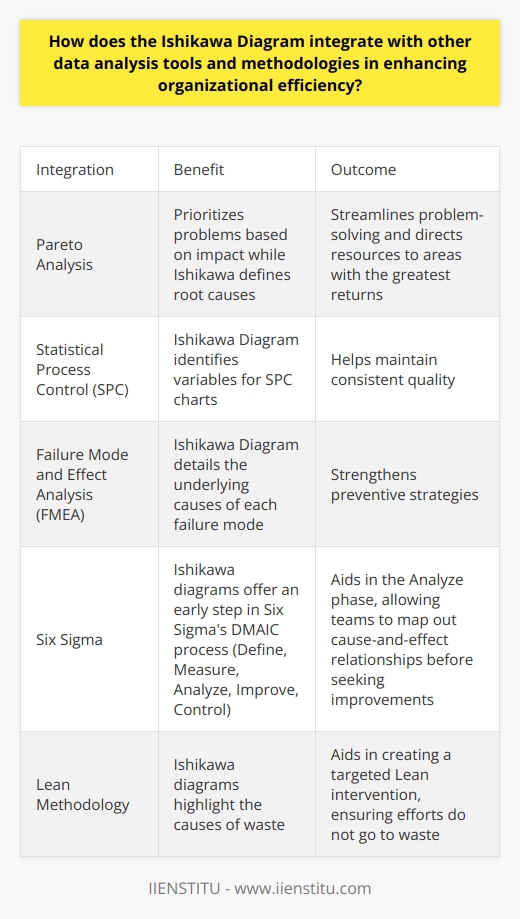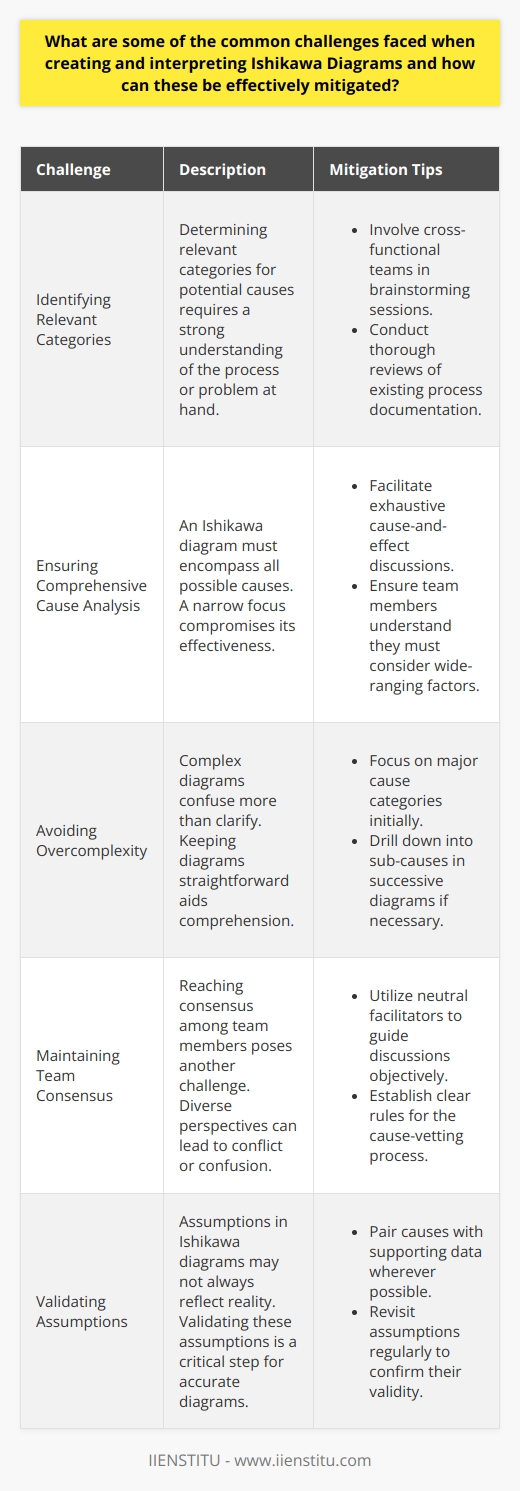
In the contemporary landscape of business and quality management, efficient problem-solving methodologies are regarded with paramount importance. Among these methodologies, the Ishikawa Diagram— also known as the Fishbone Diagram—stands out as a powerful tool for identifying, exploring, and visually displaying the roots of a particular problem. Named after its inventor, Kaoru Ishikawa, the diagram has found a multitude of uses in various fields ranging from manufacturing to education.
In this comprehensive guide, we will delve deep into the efficacy of the Ishikawa Diagram, examining its origins, structure, applications, and offering a step-by-step approach to craft and analyze this insightful tool.
Importance and Usage of the Ishikawa Diagram in Different Fields
The Ishikawa Diagram is celebrated for its ability to facilitate learning problem solving in a structured and collaborative manner. It prompts teams to look beyond superficial issues and investigate underlying causes of problems.
This quality has made it indispensable in domains like quality control, project management, healthcare, and any context where systematic analysis is key to improvement. Its simplicity and visual nature make it an engaging means of communication, able to enhance clarity and foster a collective understanding of complex issues. With its cross-industry relevance, the Ishikawa Diagram continues to evolve as a foundational element in the repertoire of analytical tools.
History and Origin of Ishikawa Diagram
Discussing the Origin and Development of the Ishikawa Diagram
The Ishikawa Diagram was developed in the 1960s, an era marked by Japan's industrial revolution, where significant emphasis was put on quality control and manufacturing processes. This tool was initially embraced by the Kawasaki shipyards but soon proliferated beyond, to become a cornerstone of the total quality management movement. It empowered workers by giving them a voice to contribute to problem-solving endeavours.
Throughout its history, the Ishikawa Diagram has transcended its original context and has been modified and refined to suit a variety of disciplines, showcasing its versatility and adaptability.
Brief Biography of Kaoru Ishikawa, the Man Behind the Diagram
Kaoru Ishikawa, born in Tokyo in 1915, was not just an inventor but a visionary who transformed management practices. A prominent professor at the University of Tokyo, Ishikawa was dedicated to quality management processes and sought ways to involve all employees—from top management to the shop floor workers—in organizational problem-solving.
Apart from the Fishbone Diagram, which remains his most renowned contribution, Ishikawa also developed the concept of Quality Circles and advocated for the internal customer concept, which emphasizes the importance of each member of the process as a 'customer' to the preceding process step.
Understanding the Ishikawa Diagram
The Structure of Ishikawa Diagram
The Ishikawa Diagram's construction is metaphorically aligned with the anatomy of a fish. At its head is the problem statement, or the "effect", to be investigated. Extending from the 'spine' of the fish are the major categories of potential causes, often generalized as Methods, Materials, Machines, People, Measurements, and Environment. It's this skeletal structure that provides the framework upon which the specifics—the ‘bones’—of the potential causes are overlaid.
The intuitive nature of this layout promotes an organized and comprehensive dissection of issues at hand.
Key Elements and Components of the Diagram
Each branch or "bone" leading off from the main axis represents an avenue of inquiry, a category of potential causes. These categories can be further broken down into sub-branches, representing sub-causes, which provide a finer granularity of analysis.
It is this hierarchical decomposition that equips the Ishikawa Diagram with the ability to handle complex and multifaceted issues by visualizing the relationship between the effect and its causes in a structured and clear-cut manner.
The Concept and Principle of Cause and Effect in Relation to the Diagram
At its core, the Ishikawa Diagram is rooted in the cause-and-effect principle, illustrating that various factors and their interplay result in the final issue or 'effect.' Its intent is not simply to list possible reasons for a problem but to delve into the systemic and sometimes hidden connections that cause the observed effect.
Through this diagram, users systematically explore the potential causes, organized by major categories, to uncover the actual reason behind the problem.
Uses and Applications of Ishikawa Diagram
Discussing the Role of Ishikawa Diagram in Problem-Solving
Problem-solving is central to improvement initiatives across various sectors. When faced with a complex issue, it can be challenging to pinpoint exactly where things are going astray. The Ishikawa Diagram serves as a guide to systematically navigate through potential causes, ensuring a thorough examination rather than a hasty conclusion.
By analyzing the 'bones' that make up the 'fish,' teams can collectively identify root causes and not just symptoms, allowing for effective solutions rather than quick fixes.
Importance of Ishikawa Diagram in the Field of Quality Management
In quality management, the primary goal is to identify and rectify flaws to streamline processes and enhance the product or service. The Ishikawa Diagram aids this pursuit by laying out a roadmap to identify quality issues, leading to a deeper understanding of the process and thus, an improved quality outcome.
As processes become increasingly complex, the use of such a diagram ensures a methodical approach to maintaining high standards and fostering continual improvement within an organization.
Use of Ishikawa Diagram in Complexity Analysis and Decision-Making
One of the significant strengths of the Ishikawa Diagram is its ability to simplify complexity. By breaking down issues into smaller, more manageable parts, it aids decision-makers in comprehending and tackling complex problems. This tool enables a more thoughtful and data-driven decision-making process, where all possible factors are considered before any measures are implemented.
Step-by-Step Guide on How to Create an Ishikawa Diagram
Preparing to Create the Diagram
Prior to engaging with the diagram, it is essential to have a clear understanding of the problem at hand. This involves gathering relevant information, ensuring accessibility to necessary resources, and assembling a team with diverse knowledge to contribute to the analysis. Identifying the scope and the boundaries of the problem is crucial; an Ishikawa Diagram is most effective when applied to a specific issue rather than an overwhelming or generalized one.
Define the Problem or the Effect
Defining the problem—also known as the "effect"—is the pivotal first step in creating your Ishikawa Diagram. This effect should be articulated as clearly and concisely as possible, setting the stage for the subsequent analysis. Once defined, this problem statement becomes the head of the fish, guiding every subsequent step in the exploration process.
Brainstorming Potential Causes
With the problem outlined, it's time for the team to employ collective brainstorming to identify all possible causes. This phase benefits from diversity of thought and open communication, as the team casts a wide net to capture every conceivable reason that might contribute to the problem. Multiple perspectives ensure that less obvious or unconventional causes are also taken into consideration.
Categorizing the Causes
After a myriad of potential causes have been gathered, they must be categorized. This involves sorting them into broader categories, such as the aforementioned Methods, Materials, Machines, People, Measurements, and Environment. These categories help in organizing thoughts and structuring the diagram, forming the main branches or 'bones' off which more detailed causes will hang.
Adding Causes and Sub-causes to the Diagram
The next step is to place each identified cause into its relevant category along the branches of the diagram. Within each category, causes are further broken down into finer details, forming sub-causes as necessary. This layered format is essential for a comprehensive and ordered analysis.
Analyzing and Interpreting the Diagram
Having constructed the Ishikawa Diagram, the final step is to analyze and interpret the findings. This process often uncovers patterns or reveals the most common categories that contribute to the problem. From here, teams can prioritize which causes to address first based on their potential impact and the resources available to create an action plan.
Advantages and Disadvantages of Ishikawa Diagram
Discussing the Benefits of Using Ishikawa Diagram
The advantages of the Ishikawa Diagram are manifold. It promotes a thorough investigation of problems, avoiding superficial diagnoses. By visually mapping out the cause-and-effect relationships, it enhances collective understanding and fosters clearer communication among team members. Additionally, the diagram's structure encourages a democratic approach to problem-solving, where each team member can contribute perspectives and insights.
Exploring the Limitations and Challenges of Using the Diagram
Despite its benefits, the Ishikawa Diagram is not without its limitations. One challenge is the potential for the process to become unwieldy, especially when too many causes are identified without effective filtering or prioritization. Another limitation is the risk of drawing incorrect conclusions if the analysis is not sufficiently data-driven or if the team has inherent biases. Furthermore, the diagram alone cannot solve the problem—it is a tool, and its effectiveness depends on how it is used.
The Importance of a Balanced Approach While Using the Diagram
To mitigate the limitations of the Ishikawa Diagram, it is critical to adopt a balanced approach. This involves being systematic yet flexible, comprehensive yet focused, and data-driven while open to insights and experiences. Confirmatory data analysis and practical tests should follow the use of the diagram to validate the identified causes before taking corrective actions. Additionally, continuous learning and feedback loops can prevent the recurrence of past oversights.
Case Studies and Examples
Presenting Real-life Case Studies Where Ishikawa Diagram has been Utilized Effectively
There are numerous real-world applications of Ishikawa Diagrams that illustrate their effectiveness. For example, in healthcare, hospitals have used the diagram to reduce patient wait times by identifying and addressing inefficiencies in their processes. In manufacturing, the diagram has been instrumental in diagnosing defects in production lines, leading to improvements in both quality and productivity.
Demonstrating the Process Through Examples
For instance, an automotive company may use an Ishikawa Diagram to dive into why a specific component is failing at a high rate. Through careful analysis, they might uncover that a combination of poorly trained staff (People), imprecise measurement tools (Measurement), and a suboptimal material (Material) is contributing to the defect. With these root causes identified, targeted interventions can be developed and implemented.
Recap of the Essential Points About Ishikawa Diagram
The Ishikawa Diagram is an exceptionally versatile tool that can dissect and clarify complex issues across industries effectively. It serves as a critical thinking instrument that structures problem analysis, facilitates communication, and promotes a culture of continuous improvement.
Emphasize the Importance of This Tool in Various Industries
The ongoing relevance of the Ishikawa Diagram in fields as diverse as healthcare, education, manufacturing, and beyond highlights its enduring value. For organizations striving for excellence, embracing such analytical frameworks is key to identifying problems at their core and crafting sustainable solutions.
Encourage More Research and Understanding About the Concept
Understanding how to properly leverage the Ishikawa Diagram can enhance one's analytical skills and elevate an organization's problem-solving abilities. It's a testimony to Kaoru Ishikawa’s legacy that his diagram remains a profound influence on modern-day quality management and decision-making processes. For professionals and organizations committed to optimal operations, mastery of the Ishikawa Diagram is a worthwhile pursuit— one that resonates with the enduring quest for knowledge and efficiency. As online certificate programs often include training in such analytical tools, they represent an accessible avenue for professionals to enhance their competency in deploying this powerful diagram.
The richness of the Ishikawa Diagram's potential is only as limited as the users' capacity to utilize it fully. With a blend of critical scrutiny and inventive application, this tool's utility remains an invaluable asset in the toolbox of problem solvers across the globe.
Frequently Asked Questions
What are the primary functions and purposes of an Ishikawa Diagram in the context of problem-solving and root cause analysis?
Understanding the Ishikawa Diagram
The Ishikawa Diagram, also known as a Fishbone Diagram, offers a visual tool for root cause analysis. Dr. Kaoru Ishikawa, a Japanese quality control expert, developed this method. It is pivotal in problem-solving and analyzing complex issues. Users trace back from effects to potential causes systematically.
Core Functions of Ishikawa Diagrams
Facilitate brainstorming: This diagram serves as a brainstorming tool. It encourages collective problem-solving. Teams often use it to generate ideas around potential causes of a problem.
Categorize causes: The diagram has several branches that categorize causes. Common categories include Methods, Machines, People, Materials, Measurements, and Environment.
Visualize relationships: A clear visual layout shows cause-and-effect relationships. This feature promotes understanding of the interplay between different factors.
Focus discussion: By outlining causes, the diagram focuses team discussions. It directs attention to specific areas.
Foster a systematic approach: The structured nature of the diagram leads teams through a rigorous process. It ensures they consider all relevant aspects of an issue.
Purposes of Ishikawa Diagrams
Identify root causes: The primary purpose lies in identifying the fundamental causes. These are the underlying factors that contribute to a problem's occurrence.
Promote collaborative problem-solving: The Ishikawa Diagram brings teams together. It encourages collaboration and collective learning.
Support continuous improvement: When teams understand problems well, they can develop more effective solutions. This understanding supports an organizational culture of continuous improvement.
Ensure comprehensive examination: The layout ensures no stone remains unturned. Teams examine every possible contributing factor to a problem.
Enhance communication: The visual nature of the diagram enhances communication. It makes complex relationships between causes more understandable. It also provides a reference point for discussions.
In sum, Ishikawa Diagrams form a powerful arsenal in problem-solving. They ensure systematic, thorough analysis. They encourage team participation and pave the way for effective solutions. Their role in root cause analysis is indispensable for many organizations striving for excellence and continuous improvement.

How does the Ishikawa Diagram integrate with other data analysis tools and methodologies in enhancing organizational efficiency?
The Ishikawa Diagram in Data Analysis Ecosystem
The Ishikawa Diagram, or fishbone diagram, offers visual simplicity. It aids users in pinpointing root causes. Yet, its full potential emerges through integration. It complements other data analysis tools. These synergies enhance organizational efficiency.
Integration with Pareto Analysis
Ishikawa diagrams often pair with Pareto Analysis. Pareto prioritizes problems based on impact. Ishikawa defines these problems’ root causes. This combination streamlines problem-solving. It directs resources to areas with the greatest returns.
Link with Statistical Process Control
Next, consider Statistical Process Control (SPC). SPC uses statistical methods to monitor processes. The Ishikawa Diagram identifies variables for SPC charts. This helps maintain consistent quality.
Synergy with Failure Mode and Effect Analysis
Failure Mode and Effect Analysis (FMEA) assesses potential failure points. The Ishikawa Diagram adds depth here. It details the underlying causes of each failure mode. This strengthens preventive strategies.
Connection with Six Sigma
Six Sigma focuses on defect reduction. Ishikawa diagrams offer an early step in Six Sigma's DMAIC process (Define, Measure, Analyze, Improve, Control). They help in the 'Analyze' phase. Teams can them map out cause-and-effect relationships before seeking improvements.
Alignment with Lean Methodology
Lean methodology targets waste reduction. Ishikawa diagrams highlight the causes of waste. They aid in creating a targeted Lean intervention. This ensures efforts do not go to waste.
Using Ishikawa for Data-Driven Decisions
Organizations thrive on data-driven decisions. Ishikawa diagrams serve as a foundation for these. They set the stage for quantitative analysis. They ensure organizations do not rely on hunches.
Informed Hypotheses Development
Ishikawa diagrams facilitate informed hypotheses development. Analysts consider various factors. These guide subsequent data collection.
Streamlining Data Collection
Once hypotheses are set, efficient data collection follows. The Ishikawa Diagram informs relevant data to gather. This prevents extraneous data clogging the analysis.
Enhancing Cross-Functional Communication
Communication bridges successful integrations. The Ishikawa Diagram simplifies complex ideas. It brings clarity to cross-functional team discussions.
Driving Continuous Improvement
Continuous improvement stands at the heart of operational efficiency. Ishikawa diagrams offer a starting point for Kaizen events. Teams can identify and tackle inefficiencies on a regular basis.
Conclusion
The Ishikawa Diagram does not stand alone. It forms vital links within a network of methodologies. This improves decision-making processes. Teams identify root causes more effectively. Organizations gain in efficiency and effectiveness. Short, clear sentences convey this complex relationship. The integration enhances strategic and tactical business decisions. Ishikawa diagrams are more than a tool. They are a bridge to organizational excellence.

What are some of the common challenges faced when creating and interpreting Ishikawa Diagrams and how can these be effectively mitigated?
Understanding Ishikawa Diagrams
Ishikawa diagrams, often known as fishbone diagrams, support root cause analysis in various industries. These tools help organizations ascertain possible causes of specific problems. Yet the creation and interpretation of Ishikawa diagrams involve several challenges.
Identifying Relevant Categories
One challenge involves determining relevant categories for potential causes. It requires a strong understanding of the process or problem at hand.
Mitigation Tips:
- Involve cross-functional teams in brainstorming sessions.
- Conduct thorough reviews of existing process documentation.
Categories must reflect all aspects that could influence the issue.
Ensuring Comprehensive Cause Analysis
An Ishikawa diagram must encompass all possible causes. A narrow focus compromises its effectiveness.
Mitigation Tips:
- Facilitate exhaustive cause-and-effect discussions.
- Ensure team members understand they must consider wide-ranging factors.
Comprehensive analysis reduces the risk of overlooking critical causes.
Avoiding Overcomplexity
Complex diagrams confuse more than clarify. Keeping diagrams straightforward aids comprehension.
Mitigation Tips:
- Focus on major cause categories initially.
- Drill down into sub-causes in successive diagrams if necessary.
This staged approach manages complexity effectively.
Maintaining Team Consensus
Reaching consensus among team members poses another challenge. Diverse perspectives can lead to conflict or confusion.
Mitigation Tips:
- Utilize neutral facilitators to guide discussions objectively.
- Establish clear rules for the cause-vetting process.
This helps maintain focus and ensures productive dialogue.
Validating Assumptions
Assumptions in Ishikawa diagrams may not always reflect reality. Validating these assumptions is a critical step for accurate diagrams.
Mitigation Tips:
- Pair causes with supporting data wherever possible.
- Revisit assumptions regularly to confirm their validity.
Data-driven validation strengthens the diagram's reliability.
Facilitating Effective Interpretation
Even well-constructed diagrams can be difficult to interpret. Misinterpretation can lead to incorrect conclusions.
Mitigation Tips:
- Provide training on Ishikawa diagram reading and interpretation.
- Create a legend or guide to explain symbols and layout conventions.
Clear interpretation guidance ensures accurate readings.
Supporting Decision Making
Ishikawa diagrams aim to inform decision-making. They must present information in a manner supportive of this goal.
Mitigation Tips:
- Prioritize identified causes based on impact and likelihood.
- Use the diagram as a starting point for further analysis or experimentation.
Prioritization helps target the most significant causes first.
The creation and interpretation of Ishikawa diagrams come with distinct challenges. Addressing these systematically enhances the effectiveness of the diagrams. It involves ensuring the relevance of categories, thoroughness in cause analysis, simplicity, consensus, assumption validation, proper interpretation, and decision-making support. When teams mitigate these challenges properly, Ishikawa diagrams serve as powerful tools for problem-solving and quality improvement efforts.



